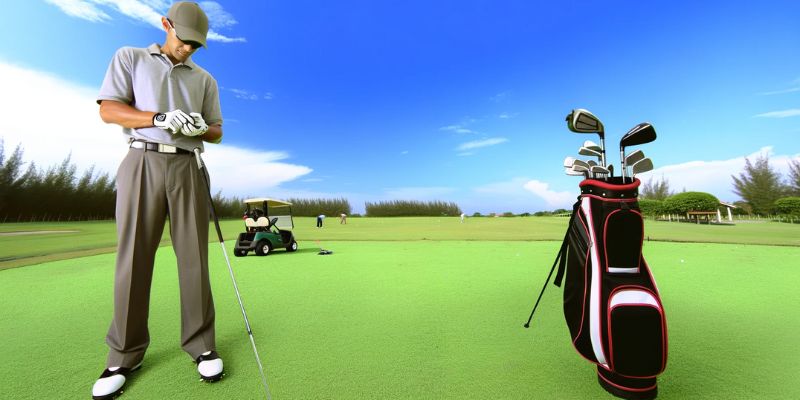
by Mark Preston | Jun 11, 2024 | Golf Equipment & Products - Reviews, Articles & Guides
Mixing older and newer clubs in a golf bag is an art that balances nostalgia with the latest advancements in golf technology.
This approach can be both cost-effective and strategically savvy, providing golfers with a unique set tailored to their specific needs.
Combining Old and New Technology
Mixing older and newer clubs isn’t just about saving money—it’s about leveraging the unique benefits that each golf club offers.
Older clubs might have sentimental value and familiarity that boosts confidence, while newer clubs come with the latest technology to enhance performance.
The key is to evaluate the condition and performance of each old club and decide whether its inclusion in your set positively impacts your game.
For example, many players prefer to keep their tried-and-true putters or irons, which they feel comfortable with, while integrating new drivers or hybrid clubs that offer better control and distance.
Benefits of Mixed Club Sets
There are several benefits to mixing older and newer clubs.
Firstly, it allows more customization based on a player’s specific strengths and weaknesses.
For instance, older irons might provide better control for some players, while newer woods and hybrids offer improvements in speed and distance.
Secondly, this mix can help smooth the transition to newer models, giving players time to adjust without completely overhauling their set.
Finally, a mixed set can be a budget-friendly approach, as players can upgrade gradually instead of all at once.
When to Upgrade Your Clubs
Deciding when to upgrade and integrate newer clubs into your bag should depend on a few factors: your current performance level, the condition of your clubs, and any noticeable advancements in technology that could improve your game.
It’s generally recommended to upgrade your clubs when:
- Your current clubs are significantly worn out.
- There’s a clear technology upgrade that addresses a weakness in your game.
- You’ve had significant changes in your physical condition or skill level.
Players should consult with a golf professional to assess their needs and get personalized advice on mixing and upgrading clubs.
This ensures that any new additions complement the existing set and genuinely enhance gameplay.
What are the signs that I should replace my old golf clubs?
You should consider replacing your golf clubs if you notice physical wear that could affect performance, like bent shafts, worn grips, or damaged heads. Performance decline, such as decreased distance or accuracy, can also be a sign.
How do I choose the right new clubs to add to my old set?
Choosing the right new clubs to add to your old set involves assessing your current game’s needs. Identify gaps in your range or weaknesses in play that could be addressed with new technology. A fitting session can also help determine the best clubs for your style.
Is it cost-effective to mix old and new golf clubs?
Yes, mixing old and new golf clubs can be cost-effective. It allows you to upgrade parts of your set as needed without the upfront cost of a completely new set. This approach lets you benefit from modern technology while retaining clubs that are still effective.

by Mark Preston | Jun 11, 2024 | Golf Equipment & Products - Reviews, Articles & Guides
Golf Club Choice is not merely about the physical characteristics of the golf clubs themselves but also significantly involves the psychological impact they have on players.
Understanding how your equipment choices affect your mental game can be as crucial as mastering swing techniques.
Mental Aspects of Club Selection
The selection of golf clubs can heavily influence a player’s confidence and mental preparedness.
A golfer’s golf club choice should align with their skill level, physical characteristics, and comfort, which directly impacts mental focus and game strategy.
For example, choosing clubs with the right shaft flex and clubhead design can help reduce performance anxiety and increase a player’s confidence in making difficult shots.
Additionally, using clubs that suit your natural playing style can free up mental resources, allowing for a more focused and less cluttered mind during play.
Psychological Benefits of an Organized Bag
An organized golf bag is not just about convenience; it plays a significant role in a golfer’s mental approach to the game.
Knowing exactly where every club is located reduces stress and mental clutter, allowing players to focus entirely on their shot.
A well-organized bag helps maintain a smooth flow during the game, minimizing distractions and promoting a positive mental state.
The psychological comfort of knowing that you have all the right tools in order and ready at hand can significantly boost a player’s confidence and overall performance.
Mindset for Successful Golfing
The final aspect of golf club choice involves the overall mindset that a golfer cultivates through their equipment and organization.
The right mental approach can often make the difference between a good golfer and a great one.
Understanding that your clubs are selected to enhance your strengths and mitigate your weaknesses can lead to a stronger, more resilient mental approach.
This mindset includes being prepared for various course conditions and shots, which again ties back to the choice and organization of your clubs.
A golfer’s bag setup and club selection should reflect a strategy that supports their mental game plan, focusing on consistency, confidence, and adaptability.
By aligning their equipment with their mental and physical needs, golfers can set themselves up for success both on and off the course.
What should I consider when choosing golf clubs?
When selecting golf clubs, consider your skill level, typical course conditions, and physical attributes like height and strength. The goal is to choose clubs that enhance your strengths and minimize challenges on the course.
How does organizing my golf bag affect my play?
Organizing your golf bag helps reduce mental clutter and stress, allowing you to focus more on your game. Knowing the exact location of each club can save time and mental energy during play, which is crucial under competitive conditions.
Why is mindset important in golf?
Mindset is critical in golf because it affects every aspect of your game—from how you approach training sessions to how you handle pressure during a match. A positive and focused mindset can improve decision-making, boost confidence, and increase your resilience on the course.

by Mark Preston | Jun 11, 2024 | Golf Equipment & Products - Reviews, Articles & Guides
Golf range practice is an essential part of any golfer’s routine, offering the perfect setting to refine skills without the pressure of a full game.
Yet, one pivotal question persists: Is it better to focus on the quality of each shot or the quantity of shots taken?
This article delves into how high-quality practice can significantly enhance your game, determining the optimal practice amount, and balancing practice with actual gameplay.
Focusing on High-Quality Reps
The quality of golf range practice sessions often trumps quantity.
When a golfer concentrates on making each shot with intention and focus, the results are substantially more beneficial.
High-quality reps involve setting small, specific targets within your practice range—this could be aiming for a particular distance or working on your swing path consistency.
The key is to engage in deliberate practice, where each swing is an opportunity to correct previous mistakes, reinforce muscle memory, and fine-tune techniques.
Tools such as video analysis or swing sensors can provide invaluable feedback, allowing you to see incremental improvements and make adjustments in real-time.
How Much Practice Is Enough?
Quantifying the perfect amount of golf range practice can be tricky and is highly individual.
Factors like skill level, personal goals, and even physical endurance play a significant role in defining each session’s duration.
However, quality should always be at the forefront.
A session where you can stay fully engaged and attentive to each shot’s mechanics is far more productive than a lengthy session filled with mindless repetitions.
As a general guideline, sessions that last between 30 to 90 minutes, depending on your concentration and physical condition, are ideal.
This timeframe allows you to maintain a high level of quality in your shots without risking fatigue, which could lead to the development of poor habits.
Balancing Practice and Play
While practicing at the range is critical, integrating these skills into actual gameplay is equally important.
Golf range practice should include scenario-based exercises that mimic course conditions to bridge the gap between practice and play effectively.
For example, practicing different lies, such as uphill, downhill, and sidehill shots, can prepare you for real-world challenges.
Additionally, spending part of your practice session on short game skills—pitching, chipping, and putting—can round out your abilities across all aspects of golf.
Golf is not just about hitting as many golf balls as you can at the range; it’s about thoughtful, purposeful practice.
Each session should leave you feeling like you’ve learned something new or improved an aspect of your game.
By focusing on quality reps, setting reasonable limits, and integrating practice with actual play, golfers can maximize their effectiveness on the course.
How often should I practice at the golf range?
Aim for at least 2-3 times per week, focusing on quality shots and specific skill goals to see significant improvement.
What is the best way to ensure the quality of practice?
Utilize tools such as launch monitors or video recordings to get real-time feedback and stay focused on making deliberate, thoughtful swings.
How can I make golf range practice more like actual gameplay?
Integrate situational practices, such as adjusting for wind conditions or targeting specific areas of the green, to mimic the variability you experience on the course.

by Mark Preston | Jun 11, 2024 | Golf Equipment & Products - Reviews, Articles & Guides
Deciding whether to carry hybrids in your golf bag can significantly influence your game on the course.
Hybrids are designed to combine the best features of woods and irons, offering a versatile option for various situations.
If you’re contemplating the inclusion of these clubs in your setup, understanding their benefits and knowing when and how to use them can be a game-changer.
Benefits of Hybrids
The primary reason to carry hybrids in your golf bag is their versatility.
Hybrids are easier to hit than long irons due to their larger sweet spots and lower center of gravity, making them more forgiving on mis-hits.
They are designed to get the ball airborne more easily, which is particularly beneficial in rough or challenging lies.
Moreover, hybrids can achieve greater distances with less effort compared to irons, which can help maintain speed and accuracy, especially in adverse weather conditions.
When to Use Hybrids Over Irons
Understanding when to opt for a hybrid over an iron is crucial if you choose to carry hybrids in your golf bag.
Hybrids are ideal for long shots from the rough, where their wider soles can glide through tougher grass more effectively than irons.
They are also preferable on long par-3s or for approach shots on par-5s, where distance and accuracy are paramount.
Additionally, for amateur golfers or those who struggle with long irons, replacing your 3-iron and 4-iron with hybrids can make those long approaches significantly more manageable.
Hybrid Selection Tips
When deciding to carry hybrids in your golf bag, selecting the right hybrid is just as important as deciding to use them.
When choosing hybrids, consider the following:
- Loft: Match the loft of the hybrid to the irons or fairway woods they are intended to replace. This ensures consistent gap coverage throughout your set.
- Shaft: Like with any other club, the shaft’s flex and material can impact the performance. Choose a shaft that complements your swing speed and style for best results.
- Head Design: Some hybrids feature adjustable lofts or weights, which can be useful for golfers who like to tweak their clubs based on specific course conditions or as their skills evolve.
Incorporating hybrids into your golf bag can transform how you approach the game, providing an edge that could be crucial in lowering scores and enhancing your enjoyment on the course
How many hybrids should I carry in my golf bag?
The number of hybrids you should carry depends on your individual game and the specific challenges of the courses you play most often. Most players benefit from carrying one or two hybrids, typically replacing their longest irons.
Can hybrids replace fairway woods?
While hybrids are generally used to replace long irons, some players also use them in place of lower-lofted woods, especially in windy conditions or when precision is more crucial than distance.
Are hybrids suitable for high handicappers?
Absolutely, hybrids are especially beneficial for high handicappers because they are easier to hit than long irons and woods. Their forgiving nature can help reduce the impact of common swing errors, improving overall play consistency.

by Mark Preston | Jun 11, 2024 | Golf Equipment & Products - Reviews, Articles & Guides
Golf bag setup for walk courses is crucial for golfers who prefer walking the course instead of riding a cart.
The way you pack and organize your golf bag can have a significant impact on your energy levels and overall performance throughout the round.
With the right setup, you can enjoy the walk and play your best golf.
Lightening Your Load
One of the first steps to optimize your golf bag setup for walk courses is to lighten your load.
This doesn’t mean leaving essential equipment behind, but rather choosing lighter versions of necessary items.
Opt for a lightweight golf bag, consider carrying fewer balls and tees, and only take the clothing and accessories you are sure to use.
Many modern golf bags offer ultra-light designs without sacrificing storage space or durability, perfect for walking golfers.
Choosing the Essential Clubs
When walking a course, it’s wise to reevaluate the golf clubs you need to carry.
Golf bag setup for walk courses often means carrying fewer clubs.
You might not need all 14 clubs allowed under the rules of golf, depending on the course and your game style.
Select versatile clubs that cover various situations. For instance, a hybrid can replace both a fairway wood and a long iron.
This reduction not only lightens your bag but also simplifies your club selection during the game.
Adjusting for Terrain and Distance
Another consideration for your golf bag setup for walk courses is the specific terrain and typical distances of the courses you play.
Courses with lots of elevation changes and longer distances between holes demand more energy, so every ounce saved can help.
Additionally, adapt your equipment to the course layout. For example, if you’re playing a course with lots of sand traps, make sure you have a reliable sand wedge.
Optimizing your golf bag setup for walk courses can transform your walking rounds from a grueling trek to an enjoyable part of your golf experience.
By lightening your load, selecting essential clubs, and adjusting for terrain, you can save energy, improve your performance, and have more fun on the course.
How much weight should I carry in my golf bag for walking?
Ideally, keep your golf bag under 20 pounds when walking the course. This weight allows for essential clubs, a few balls, tees, a water bottle, and minimal additional gear without becoming burdensome.
Is it better to use a double strap or a single strap golf bag for walking courses?
A double strap golf bag is generally better for walking courses as it distributes the weight more evenly across your shoulders, reducing the strain and potential for fatigue or injury.
Can the organization of my golf bag affect my play on walk courses?
Absolutely! Efficient organization of your golf bag ensures that everything is easily accessible, which speeds up your play and reduces the physical strain of searching through cluttered pockets. Place frequently used items like balls, tees, and your rangefinder in accessible pockets and organize your clubs in a logical order.





